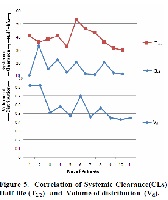Prospective observational study of vancomycin injection in SLED patient of ethnic Indians
Keywords:
Vancomycin assay, Slow-low efficiency dialysis, Pharmacokinetic analysis, Ethnic indiansAbstract
As the Vancomycin is itself a nephrotoxic antibiotics, so it is sometime recommended to the Slow-low Efficiency Dialysis (SLED) patients against highly resisted infection. In this case, the dose monitoring is strictly maintained after Intravenous injection. The collected blood was analyzed for its concentration in HPLC for 11 patients and the half life was evaluated to study Therapeutic drug monitoring. The T1/2 of evaluated vancomycin is 39.12+ 6.81 hrs. The mean of the systemic clearance is 16.91+6.99 and mean Vd is 0.57+ 0.147. Comparatively the reported study of Mean + SD of halflife, volume of distribution, and systemic clearance were 43.1 + 21.6 hours, 0.84 L/kg + 0.17 L/kg, and 24.3 mL/min + 8.39 mL/min respectively. Thus the t-test of the means was 0.5828, degree of freedom (df) was 20, standard error of difference was 6.829 and so, the two-tailed P value is 0.5665 i.e. P > 0.5. In ethnic Indian SLED patients, T1/2 of mean + SD of 39.12 + 6.81 hrs was compared to the Caucasian patients i.e, 43.1 + 21.6 hrs. And the t-test and P-value is 0.5828 & 0.5665 respectively. Thus it was concluded that the half-life of ethnic Indian patients is less in compare to Caucasians but this difference is not so significant. The half-life of ethnic 8 patients is less than 40 out of 11 patients.
References
Ryszard Międzybrodzki, Wojciech Fortuna, Beata
Weber-Dąbrowska, Andrzej Górski. Phage therapy
of staphylococcal infections (including MRSA)
may be less expensive than antibiotic treatment.
Postepy Hig Med Dosw. (online), 2007;61:461-
Cynthia Ginsberg, Stephanie Brown and
Suzanne Walker. Bacterial Cell Wall Components.
Glycoscience, 2008;6:1535-1600.
Lundstrom T, Sobel J. Antibiotics for gram-positive
bacterial infections: vancomycin, quinupristindalfopristin, linezolid, and daptomycin. Infectious
Disease Clinics of North America, 2008;18:651-
Vanholder R, Van Biesen W, Lameire N. What is
the renal replacement method of first choice for
intensive care patients? J Am Soc Nephrol.
;12:S40–3.
Marshall MR, Golper TA, Shaver MJ, et al.
Sustained low-efficiency dialysis for critically ill
patients requiring renal replacement therapy.
Kidney Int.2001;60:777–85.
Amerling R, Caraiani NS, Hafeez T, et al. CVVHD
with modified Fresenius 2008H: Initial experience .
J of Am Soc Nephrol. 1988;9:166A.
Schlaeper C, Amerling R, Manns M, et al. High
clearance continuous renal replacement therapy
with a modified dialysis machine. Kidney Int.
;72:S20–3.
Das R, Pal TK , Nandy BC, Duttagupta S.
Development of method of analysis for estimating
the Vancomycin in blood plasma by RP-HPLC
method: Application to in vivo Studies. Der
Pharmacia Lettre, 2010;2:201-210.
John W. Ahern, Carl J. Possidente. Experience with
Vancomycin in Patients Receiving Slow LowEfficiency Dialysis. Hospital Pharmacy, 39:138–





